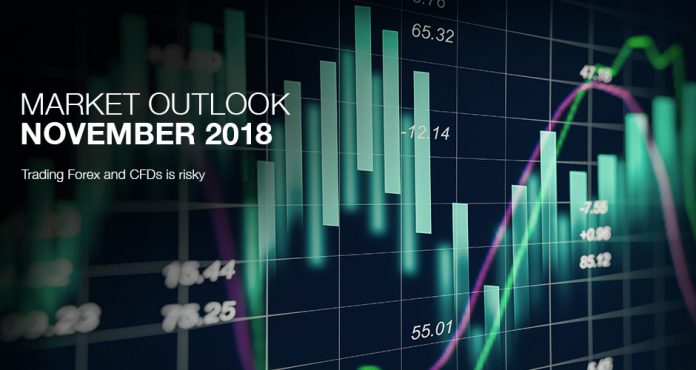CURRENCIES
Dollar: The Dollar has been gaining strength over the last month, as the US economy still boasts of high growth and a potential for higher interest rates. A stabilization of the USD is expected in the following month, although positive surprises in the domestic front could materialize, with NFP results coming up early in the month (November 2). The November 6 midterm elections are bound to cause some volatility in the markets, while Fed is expected to confirm its intention of a rate hike in December on November 8. Other important releases include the PCE Index on November 29 and the preliminary Q3 real GDP estimates on November 28.
Euro: Developments in the Euro have been mostly negative, as the common currency depreciated with respect to most of its counterparts on account of higher uncertainty and risk aversion due to the Brexit and Italian budget issues. In November, the European Commission is expected to post its growth forecasts on the 8th, with preliminary Q3 GDP results expected to come out on the 14th. The official October CPI will be released on the 16th, while the November preliminary CPI will come out on November 30.
Sterling: One of the few currencies which lost to the Euro in October, Sterling still falls prey to Brexit uncertainty and domestic politics. Picking up from the October stalemate, EU leaders will hold another Brexit summit on November 17-18, with hopes of finalizing the deal. Other important dates include the interest rate decision on November 1, and preliminary GDP results on November 9.
Yen:In October, the currency traded stronger against the Dollar, on account of better than expected Japanese economic performance. This performance is expected to continue over the next months, with BoJ monetary policy minutes on November 5 expected to shed light as to the policymakers view. Other important releases include GDP on November 13 and the Tokyo CPI on November 30.
Aussie: The Aussie has gained against the Euro and the Loonie, albeit losing ground against the Dollar. Macro developments were better than expected, especially on the housing/real estate sector, and helped ease off some worries. November starts with important data releases such as Trade Balance (November 1) and Retail Sales (November 2), with an interest rate decision on the 6th.
Loonie: BoC raised interest rates to 1.75% in October, setting the tone for more rate hikes, albeit at a more gradual rate than the Fed. Macroeconomic developments have been beneficial for the country, with CPI and Retail Sales coming out on November 23.
Emerging: The Russian economy and the Ruble are expected to stabilize over the month, with no major developments expected. The same holds for the ZAR, albeit with the South African economy appearing much more fragile. The Turkish Lira appears to have overcome the issues it faced over the summer, in a trend which is expected to continue conditional on no negative developments for the Turkish economy. The Peso declined due to a decision to scrap a new airport, albeit with no fundamentals suggesting that this will continue.
COMMODITIES
Gold: As expected, when risk aversion rises, the price of Gold jumps. October confirmed this, as the price jumped over USD1200 mark in a single day, as uncertainty increased. It has since continued to trade above the USD1200 mark, as uncertainty persisted. The stock market pains also played a role in the price increase, although this is not expected to continue for long. As interest rates around the world rise, the price of Gold is expected to decline further, likely below the USD1200 mark in the near future.
Silver: The price of Silver appears to have more or less stabilized around the USD14-14.70 channel since September, despite a small upwards trend observed in the data. Silver does register a strong positive correlation with Gold, however, its reactions are much smaller. The longer-term trend appears to suggest a negative move, perhaps towards the USD14 mark by the end of the year if interest rate hikes persist across the globe.
Oil: Oil peaked at USD76 and returned to USD66 in October, following two important events: the potential sanctions on the production of Iranian Oil by the US which pushed the price up, and the estimated increase in Saudi and Russian production which brought the price back to its September levels. In addition, weaker than expected US macro data also put downwards pressure to the price. The Saudi production is expected to increase by more in November and should put more downwards pressure, despite a growing world economy. The OPEC meeting on December 6 is also likely to provide insights to the future of Oil supply.
INDICES
US: In one of the most iconic drops in the last decade, the three indices (US30, US100, and US500) declined by more than 10% during the month, in an array of developments including increased risk aversion, worse than expected macroeconomic developments, and a decrease in corporate profits as a result of the hurricane season and the China tariffs which have increased production costs, especially among automobile manufacturers. Pressures are expected to ease in the coming month, although the expected rate hike can also put exert downwards pressure on the indices.
Europe: Stock markets in Europe chimed in the overall negative performance in October. Despite the Italian budget issue and the continued Brexit uncertainty, the UK100 declined by 9% (peak to trough). The GER30 also lost significant ground, following the global developments as well as Angela Merkel’s decision to step down from the CDU party. EUR50 moved along the same lines, losing approximately 10% of its value. The notable difference between European and US Indices is that the latter have been recording more consecutive increases in last days of October, supporting the argument that the China trade tariffs are the main cause of the decline.
CRYPTOS
Bitcoin: September was a low volatility month for Bitcoin, as its price fluctuated around the 6180-6700 channel, despite a one-off jump to the 7300 level. The longer-term trend shows signs of price stabilization for Bitcoin, leaving traders wondering what will come next. While there have been signs of a downwards move in the last trading days of October, its future potential is still a mystery, even though there have also been signs that it could act like a safe haven asset when risk aversion increases, given that there will always be a demand for private transactions.
Ripple’s price was boosted by an agreement in mid-September for the Ripple Company to provide a transaction platform to the ninth largest bank in the US. The deal pushed Ripple’s price to USD0.49, however, it has followed the overall downwards trend of Bitcoin after the spike, but has been generally trading above USD0.40. In contrast, Ethereum and Litecoin have been following the Bitcoin path, registering only a small increase when Ripple’s price spiked. Still, the three Cryptos cannot avoid following the Bitcoin path in the future, evident in Ripple’s behavior since the one-off event.
BONDS
US10Year: The rise in risk aversion observed in October decelerated the increase in the bond yield, and the subsequent drop in its price. This development, attributed to a number of factors such as the Kashoggi incident, increased trade tensions especially as a result of the China tariffs, as well as the stock market drop in late October. Nonetheless, the risk aversion regime is expected to subside in the future which, in association with expectations of a Fed rate hike in December, should put upward pressure on the yield.
UK Gilt: In the overall spirit of increased risk aversion, UK’s yields have also experienced an increase in October. Increased uncertainty about the final outcome of the Brexit agreement – as Theresa May faces opposition within her own party and European leaders do not appear to have reached concession for a final deal – pushed investors away from the bond. However, the UK Gilt has been trading stronger in the last days of October, although a potential increase in Brexit uncertainty could push it back down again. An additional uncertainty factor relates to the BoE behavior regarding its interest rate setting, as the possibility for another rate hike in 2018 still exists.
EUBund: The Bund yield increased significantly in the first days of October as US uncertainty rose, but the combination of the Brexit non-agreement and the Italian budget issues pushed the yield down. The expected end of the cheap money era in December should put some upwards pressure on the yield, especially in anticipation of rate hikes in late 2019. Still, the yield rise is not expected to be rapid.
*All data and references for the above were obtained from the following sources (unless otherwise specified): HotForex Analysis (various articles), HotForex Economic Calendar, and the MT4 platform.
Click here to access the HotForex Economic calendar.
Want to learn to trade and analyse the markets? Join our webinars and get analysis and trading ideas combined with better understanding on how markets work. Click HERE to register for FREE! The next webinar will start in:
[ujicountdown id=”Next Webinar” expire=”2018/11/07 14:00″ hide=”true” url=”” subscr=”” recurring=”” rectype=”second” repeats=””]
Dr Nektarios Michail
Market Analyst
HotForex
Disclaimer: This material is provided as a general marketing communication for information purposes only and does not constitute an independent investment research. Nothing in this communication contains, or should be considered as containing, an investment advice or an investment recommendation or a solicitation for the purpose of buying or selling of any financial instrument. All information provided is gathered from reputable sources and any information containing an indication of past performance is not a guarantee or reliable indicator of future performance. Users acknowledge that any investment in FX and CFDs products is characterized by a certain degree of uncertainty and that any investment of this nature involves a high level of risk for which the users are solely responsible and liable. We assume no liability for any loss arising from any investment made based on the information provided in this communication. This communication must not be reproduced or further distributed without our prior written permission.



















